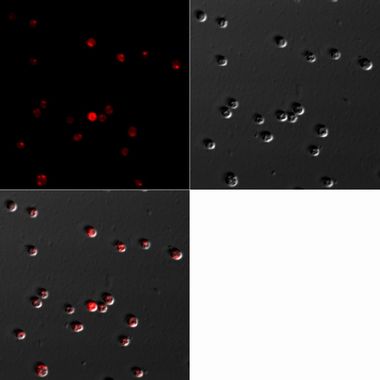May 4, 2014
RIKEN Improves Photosynthesis Bioplastic Production to World's Highest Level
Keywords: Environmental Technology University / Research institute

A microscope image of a genetically modified cyanobacterium.
Red dye indicates the likely accumulations of PHA.
Photo courtesy of RIKEN / Photo by Ng Kiaw Kiaw
RIKEN, Japan's comprehensive science research institution, announced on January 23, 2014 that its joint research with Universiti Sains Malaysia using genetically modified cyanobacteria yielded the most efficient bioplastic production by photosynthesis in the world.
Although bioplastic has begun gaining broader usage with its significantly lower environmental burden when compared to its petrochemical counterpart, production costs have been a drawback for one such bioplastic, polyhydroxyalkanoate (PHA). It is typically produced by bacterial fermentation, which requires bacterial cultivation equipment and large amount of sugar as carbon source for the bacteria.
The joint research team focused on photosynthetic cyanobacteria that exclusively use atmospheric carbon dioxide to grow. They introduced genes from bacteria that contribute to the synthesis of bioplastic into these cyanobacteria, and cultivated them in mineral salt medium to induce photosynthesis using atmospheric carbon dioxide. The genetically modified cyanobacteria produced PHA at 14 percent of their dry weight, which is the highest reported level of PHA production by photosynthesis alone. When 0.4% acetic acid was added, the production was successfully raised to 41%.
These results are hoped to advance photosynthetic bioplastic production as a greener, safer and more economical process.
Related
"JFS Newsletter"
Related
"Popular Articles"
- New Nano-Bubble Technology May Help Dissolve Sludge and Improve Water Quality
- Japanese Firm Begins Development of Tidal Power Generation System
- Small Hydropower Generation System Developed for Use in Seawater, Weight Cut by Half
- Constructed Wetland Facility Established by Japanese University Purifies Livestock Farming Drainage
- Toyota CRDL Succeeds in World's First Artificial Photosynthesis Using only Water and CO2


